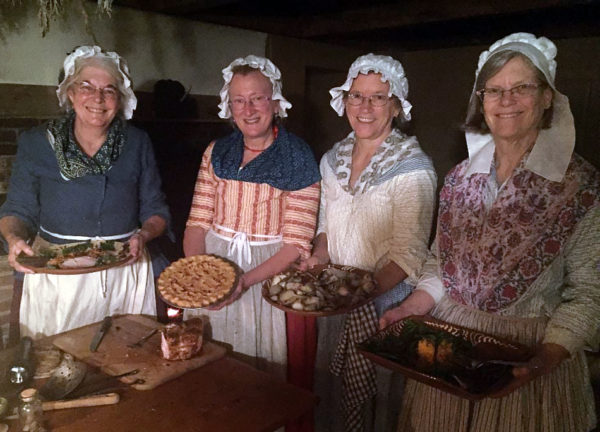When Marlborough pie is served at hearth dinners at the Colonel Paul Wentworth House, it is baked on the hearth in a bake kettle, but you can make it at home in your oven. Read on to learn about the history of this traditional New England dessert.
Today, no Thanksgiving meal would be complete without pumpkin pie. But there was a time when another pie was equally popular at Thanksgiving, at least in New England. Reflecting on his Boston upbringing in A New England Boyhood (1893), the writer Edward Everett Hale recalled:
There were certain peculiarities in the Thanksgiving dinner which there were not on common days. For instance, there was always a great deal of talk about the Marlborough pies or the Marlborough pudding. To this hour, in any old and well-regulated family in New England you will find there is a traditional method of making the Marlborough pie, which is a sort of lemon pie, and each good housekeeper thinks her grandmother left a better recipe for Marlborough pie than anybody else did. We had Marlborough pies at other times, but we were sure to have them on Thanksgiving Day.
Frequently served at hearth dinners at the Colonel Paul Wentworth House, Marlborough pudding is essentially an apple lemon custard pie with an interesting history. First, the name: in 18th and 19th century cookbooks, the term “pudding” often referred to a one-crust open pie, so Marlborough pudding is in fact a pie. How it acquired the name Marlborough is unknown. There are towns by that name in four New England states and perhaps it is named for one of them.
It is also possible that the dish was named in honor of John Churchill, first Duke of Marlborough and an early 18th century British military hero (and coincidentally an ancestor of Sir Winston Churchill), but that is sheer speculation.
Whether or not it’s called Marlborough pudding or pie, several 18th and 19th century cookbooks contain recipes very similar to this one found in the first truly American cookbook, Amelia Simmons’ American Cookery (1796):
Take 12 spoons of stewed apples, 12 of wine, 12 of sugar, 12 of melted butter, and 12 of beaten eggs, a little cream, spice to your taste; lay in paste No. 3, in a deep dish; bake one hour and a quarter.
It is unclear why Marlborough pie fell out of favor. Some modern writers claim that the recipe was a way to use up older apples which were turning mealy or mushy, and it became irrelevant when modern shipping and refrigeration made apples in good condition available year round. Others suggest that, due to the growing temperance movement, the pie was frowned upon because some recipes included wine or sherry. Whatever the reason, Marlborough pie is delicious and easy to make, and deserves a renaissance. Give it a try!
Marlborough Pie
The recipe used by the Colonel Paul Wentworth House is based on a recipe by the 19th century writer Lydia Maria Child. Our recipe calls for lemon instead of sherry and grated apple which gives the pie a nice texture. If you prefer, one cup of unsweetened applesauce can be substituted for the grated apple.
Juice and zest of one lemon
2-3 large fresh apples
1 cup sugar
½ cup butter, softened
3 eggs
8 or 9-inch unbaked pie crust
Preheat oven to 400 degrees. Squeeze lemon juice and grate peel into large bowl. Peel apples, grate into lemon juice and toss to coat. Stir in sugar. Cream butter and eggs together, add to fruit mixture. Pour into prepared pie crust. Bake at 400 degrees for 15 minutes, then reduce heat to 350 degrees and bake for 45 minutes or until pie is set (knife inserted in center comes out clean). Cool before serving.



